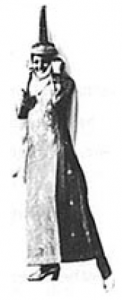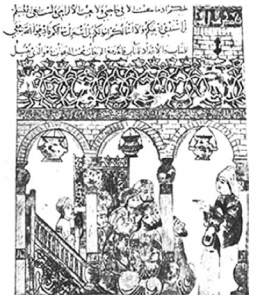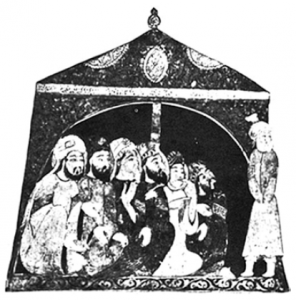Part II: Religions of the Arabs
Chapter 6: The Status of Women
Islam was a liberating force for Arab women, freeing her from the possession and accessory status of Pre-Islamic conditions. In its earliest laws, Islam recognized women as an independent being with rights and responsibilities. It allowed her to keep her family name after marriage. She could own property and dispose of it at will without consultation or permission from husband or guardian.
The Muslim woman could become a guardian over minors. In some instances, she could enter law and politics and serve as a judge. The Muslim woman has equality with men in the conduct of business, trade or profession. She may sue others in court without her husband’s permission, since she is considered an individual in her own right.
Misinformation concerning the veiling of women has created an image of suppression of women in the Arab world. Dr. Shwikar Elwan, in her paper on, “The Status of Women in the Arab World,” says: “As far as the veil and seclusion are concerned, neither Islam, nor pre-Islamic Arabia are responsible for that. Women in Arabia were not segregated; in fact, they engaged in trade and even fought side by side with men. Islam did not put restrictions on women’s participation in public life, nor did it deny them the right to work. Seclusion, the veil and the harem were customs borrowed from Byzantine and Persian societies at a much later date. In fact, when the conquering Arab tribes entered Syria, they encountered veiled Christian women.”



The veil was a symbol of the upper class, aristocratic woman. It was adopted as a mark of distinction by well-to-do women. The Bedouin women in North Africa and the peasant women in Egypt have never worn the veil. The Qur’anic chapter, relating to “hijab,” refers to the family of the prophet himself, suggesting privacy and withdrawal. In the early years of Islam, women enjoyed the freedom and equality guaranteed to them by their religion.”
Dr. Elwan suggests that as Islamic culture and civilization declined, women were excluded from the education and community participation they had enjoyed at an earlier date. She adds that as the Arab world moved toward modernization, it was realized that real progress could not be achieved until nearly half the population, the women, were permitted once again the rights and liberty that were theirs in earlier centuries. Emancipation of women in the modern Arab world began about the same time as cries for emancipation from women in the west became louder — late in the nineteenth century.
Bahithat-el-Badiya, a woman writer in the nineteenth century fought for compulsory education for girls as well as boys. Women’s magazines began to appear, and women began to participate in the struggle for independence in their countries. Still wearing the veil, the first suffragettes of Egypt, led by Hoda Sha’arawy, demonstrated in 1919 against British occupation forces. Facing the British guns, they challenged the British ultimatum to shoot at public protest meetings. In 1923, their organization became affiliated with the International Alliance of Suffragette Women.
In 1922, Egyptian girls, often supported by their fathers and brothers, won the right to education by all the means at their disposal — demonstrations, hunger strikes and defiance of the courts — paving the way for education of the generations who came after. In Egypt today, for example, at least one third of the university students are women, a large percentage of them enrolled in the schools of medicine and engineering.
Women have participated in revolutionary activity in a number of Arab countries in the twentieth century. In the fight for Lebanese independence in 1943, Lebanese women marched through the streets of Beirut protesting the arrest of political figures by the French Mandate government. During their Revolution, Algerian women with much anguish and self-sacrifice, stood behind their men and restored Algeria once again to her own people.
Changing social attitudes in a number of Arab countries today, including Libya, Iraq, Syria, Jordan, Kuwait, Egypt and Lebanon, not only permit, but encourage women to work. In fields such as journalism we find that, in Egypt alone, two hundred and fifty women are enrolled as members of the Journalists’ Union.
While Islam permits polygamy up to the taking of four wives, the religious and legal requirements are such that this life style has all but disappeared from modern Arab society.
Thus, in marriage as in most of their other activities, modern Arab women live as do their counterparts in other societies.
